Co-creation of Sustainable Regional Innovation for Reducing Risk of High-impact Environmental Pollution
- FS①
- PR
- FR①
- FR②
- FR③
- FR④
- FR⑤
2021
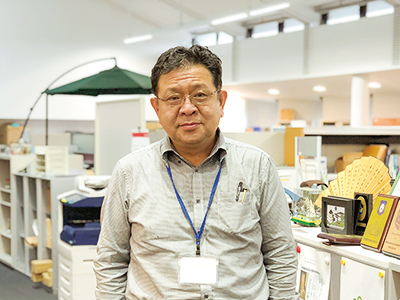 Project Leader
Project LeaderSAKAKIBARA Masayuki
RIHN/Ehime UniversityProfessor Masayuki Sakakibara is an earth scientist with multidisciplinary backgrounds: Geology, Petrology, Astrobiology, Geochemistry, Medical Geology, Geoengineering, and Remediation Engineering. He is currently also working at the Faculty of Collaborative Regional Innovation and Graduate School of Science and Engineering, Ehime University. His interest in environmental pollution led him to conduct intensive fielworks and activities to reduce mercury pollution and poverty problems in artisanal and small-scale gold mining (ASGM) areas in Indonesia and Myanmar. He takes responsibilities of international conferences and seminars such as Transdisciplinary Research on Environmental Problems in Southeast Asia (TREPSEA) and Transdisciplinary Research and Practice for Reducing Environmental Problems (TRPNEP), which focus on transdisciplinary research and practice, as well as development of various regional innovations for the reduction of environmental pollutions in ASEAN countries.
>> Annual Report>> Project's Page
| Researchers at RIHN | |
| KIMIJIMA Satomi | Researcher |
| WIN THIRI KYAW | Researcher |
| METARAGAKUSUMA, Andi Patiware | Researcher |
| MYO HAN HTUN | Research Associate |
| TAKEHARA Mari | Research Associate |
| Main Members | |
| MATSUDA Hiroyuki | Yokohama National Universityy |
| KASAMATSU Hiroki | Ehime University |
| SHIMAGAMI Motoko | Ehime University |
| MIYAKITA Takashi | Kumamoto Gakuen University |
| MATSUMOTO Yuichi | Kwansei Gakuin University |
| KOMATSU Satoru | Nagasaki University |
| ISA, Ishak | State University of Gorontalo |
| JAHJA, Mohamad | State University of Gorontalo |
| ABDURRACHMAN, Mirzam | Institut Teknologi Bandung |
| KURNIAWAN, A. Idham | Institut Teknologi Bandung |
| ARIFIN, Bustanul | Lampung University |
| ISOMONO, Hanung | Lampung University |
| BASRI | College of Health Sciences Makassar |
| BOBBY | Network Activities Groups |
Research Background
Mercury (Hg) is an extremely toxic metal and a particular threat to human embryonic and early-childhood development. Recent investigation by the United Nations Environment Programme (UNEP) has highlighted the enormity of Hg pollution in developing countries. ASGM produces 15-20% of the global gold market and is responsible for 37% of global Hg emissions, as mercury amalgamation is a cost-effective and widely used method to extract gold from ore. Around 15 million people, including 4-5 million women and children, participate in ASGM activities in more than 70 countries. Even though the Minamata Convention was established to protect human health and the environment from the adverse effects of Hg, ASGM activities are oft en associated with poverty and cannot be solved by ratifi cation of international treaties or NGO activities alone.
Research Objects
The objectives of our project are to: 1) understand the link between poverty reduction and environmental management in ASGM areas; 2) establish a process for constructing sustainable societies through regional innovations in ASGM areas; and 3) strengthen environmental governance in ASEAN countries.
Methodology and research process
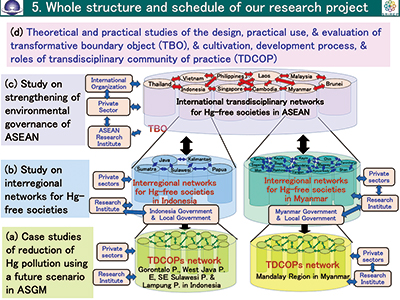
Figure 1 Structure of SRIREP project
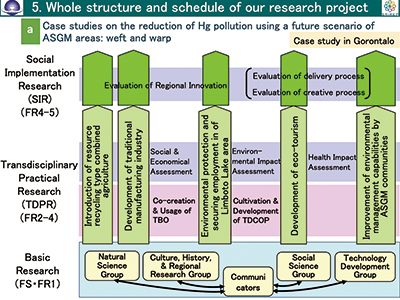
Figure 2 Structure and schedule of the case studies in Gorontalo, Indonesia.
We have been conducting transdisciplinary research and practice in collaboration with mining communities, key stakeholders (SHs) of public and private organizations, and researchers of local universities, etc. (Figure 1). This work emphasizes:
- a)
- b)
- c)
- d)
Expected goals of the project
Regional innovation will arise as a consequence of environmental and industrial innovations introduced with a transdisciplinary approach, including the development of a future scenario for a Hg-free society, transformative learning and practice, and developments of TDCOPs. By strengthening environmental governance, which consists of multiple layers of co-operative organizations, we will also develop a route through which the problem of global environmental Hg pollution can be resolved.
Progress and Achievements
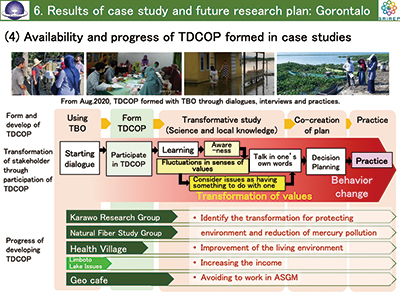
Figure 3 Availability and progress of TDCOPs established in the case study of Gorontalo, Indonesia.
- a)
- b)
- c)
- d)
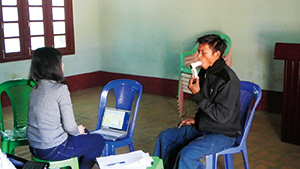
Photo 1 Health impact assessment of ASGM miners in Mandalay Region, Myanmar in February 2020; assessment of the lung capacity in ASGM miners using a portable spirometry
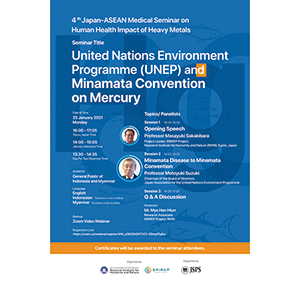
Figure 4 Flyer of the 4th Japan - ASEAN Medical Seminar on the Human Health Impact of Heavy Metals
